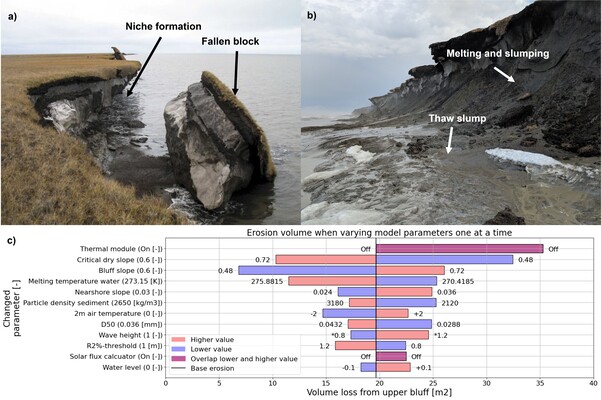K. de Bruijn1*, L. Erikson2 , R. McCall3; C. Nederhoff4; S. Pearson1; T. Ravens5; C. Seyfert3; W. Uijttewaal1
1 Delft University of Technololgy, The Netherlands; 2 United States Geological Survey, USA; 3 Deltares, The Netherlands; 4 Deltares USA, USA; 5University of Alaska Anchorage; USA
* K. de Bruijn: kevinhermanusd@tudelft.nl
Introduction
Permafrost affects over 30% of the world’s coastline. These coasts are susceptible to rapid erosion rates of up to 2 – 10 meters per year (Lantuit, 2012). In the Arctic, erosion mechanisms differ from conventional low-latitude coastlines like the Netherlands due to the importance of thermal processes (Ravens, 2017). First, the seasonal presence of sea ice attenuates waves for a large part of the year. Second, sediment can only be eroded when thawed due to one of the two dominant erosion processes, which are called thermal abrasion (Figure 1a) and thermal denudation (Figure 1b). Models are being developed for these environments but are in their pioneering stages.
The Arctic region is undergoing transformative environmental shifts due to global warming. For example, the number of days the Arctic sea remains open has been rising. This enables the creation of larger waves due to longer fetches. Moreover, warmer air temperatures and increased permafrost temperatures are all linked to increased coastal erosion. This study delves deeper into the mechanisms at play, particularly thermal denudation, to enhance our ability to simulate and predict erosion for permafrost-affected coastlines.
Objective and Methods
To research the effect of climate change on thermal denudation-affected coastlines, we required a process-based model with the ability to simulate extended periods of time. Ravens et al. (2017) provided a starting point. They present a method for modeling Arctic erosion, referred to as ‘Arctic XBeach’. Their model integrates a thermal model directly into XBeach. To facilitate the simulation of climate change time scales, we developed a Python wrapper that decouples the thermal model from XBeach. The thermal model simulates the ground temperature to determine an erodible layer. It is relatively fast and can run continuously, while the wrapper only activates XBeach during periods with expected morphological change, i.e., during storms. This change allowed us to simulate decades instead of just single storms.
Including the thermal model led to better predictions of Arctic coastal retreat and a better understanding of thermal denudation (Figure 1b). Validation against observed data at Barter Island (AK) confirmed the model's reliability, with skill scores showing accuracy in predicting ground temperature and coastal retreat. Moreover, our findings highlight the critical need to include thermal processes when modelling Arctic erosion, which requires the integration of thermo-, hydro-, and morphodynamics to accurately hindcast erosion in the Arctic.
Results
Our sensitivity analyses indicated that the environmental drivers affected by climate change (i.e., air and sea temperatures, water level) will accelerate the erosion of permafrost-affected coastlines under the effects of climate change, confirming the findings of previous work. For example, an increase in air temperature of 2 degrees resulted in >10% more erosion. Additionally, an increase in sea level of 0.1 meters resulted in over 15% more erosion (Figure 1c). Moreover, rising temperatures will compound with diminishing sea ice to widen the annual window during which erosion can occur, which will increase the number of storm events that lead to erosion. We showed that lower bluffs composed of finer sands are especially vulnerable, with a 20% smaller mean sediment diameter resulting in 25% more erosion (Figure 1c).
The low computation cost means that the model can be applied to predict coastal erosion for larger regions, potentially benefiting strategic coastal management and policymaking. The developed model can be used as a tool to research the quantitative effects of climate change on the erosion of Arctic coastlines and gain a deeper understanding of how climate change affects the processes that ultimately lead to the erosion of permafrost bluffs.

Example of thermal abrasion (Figure 1a, Drewpoint, AK. Photo by Benjamin Jones, 2017), example of thermal denudation (Figure 1b, Barter Island, AK. Photo by Shawn Harrison, 2018), and most sensitive parameters found during sensitivity analysis with the developed model (Figure 1c).
References
Lantuit, H., Overduin, P. P., Couture, N., Wetterich, S., Aré, F., Atkinson, D., Brown, J., Cherkashov, G., Drozdov, D., Forbes, D. L., Graves-Gaylord, A., Grigoriev, M., Hubberten, H.-W., Jordan, J., Jorgenson, T., Ødegård, R. S., Ogorodov, S., Pollard, W. H., Rachold, V., ... Vasiliev, A. (2012). The Arctic Coastal Dynamics Database: A New Classification Scheme and Statistics on Arctic Permafrost Coastlines. Estuaries and Coasts, 35(2), 383–400.
Ravens, T., Ulmgren, M., Wilber, M., Hailu, G., & Peng, J. (2017). Arctic-capable coastal geomorphic change modeling with application to Barter Island, Alaska. OCEANS 2017 - Anchorage, Anchorage, AK, USA, 2017, pp. 1-4.


